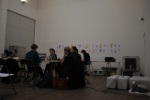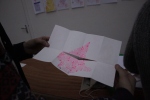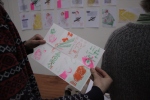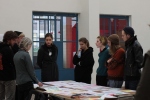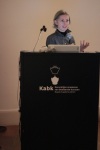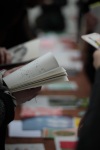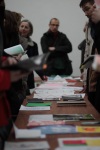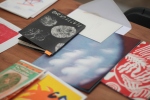The group of students already made there second and third publication about breakfast.
See the results here, or come to the presentation at 17:00h in the gallery on the KABK.
Category Archives: Risotating leaves
Risotating leaves
At the end of the first week, we ask some questions to a couple of students. What do they think of the workshop and what did they learn so far?
From the workshop Ristotating leaves we talked to Kristina, she is studying graphic design in Lithuania.
Why did you choose for this workshop?
The discription of the workshop sounded really interesting. The technique of the risograph machine is amazing. You can work in layers en experiment a lot. Sometime you fail but it’s very easy to try again.
What did you learn so far?
Of course the technique, i never worked with a risograph machine before. Also the workshop makes your think more about the steps you take and the end result you getting. We started the workshop with all the students making a image. Then we took each others images and combined it with our one image. The outcome was amazing. Working together is a big part of the workshop, i really like it.
How is it to work with students and teachers from different countries?
I really want to work with teachers from a different country than my one. I also think it’s important to work with student an teachers from different countries. The interaction and the different view on design is nice to see. The teachers are really open and free-minded.
What are the plans for the next five days of the workshop?
We are now making a group publication about breakfast. Also we are going to spread the publication in the city. We don’t know how much time we need, but if we are going to finish it really fast we are going to make more publications on the risograph.
Risotating Leaves: Riso experiments and repetition
Yesterday the students did some riso experiments. They worked as a group on repetition on the riso. They made a little booklet from their experiment. Their sketching, dicussing and experimenting for possible approaches to form and idea of collective publication that allows space for individual contributions.
Risotating Leaves: Getting Started
After the Lectures in the morning, the workshops started.
With the workshop Risotating Leaves, the group is going to work on a risograph.
For the IP project a risograph machine is placed in the gallery.
To know more about the Risograph machine: http://en.wikipedia.org/wiki/Risograph
The group of students is going to work together to make a publication on the Risograph machine. It’s working together, getting to know a new technique and learning about the distribution of a publication.
The workshop is given by Ewoud van Rijn and Karin de Jong
they are from www.printroom.org
IP Workshop: Risotating leaves
the title of the workshop refers to cadavre exquise, also exquisite corpse or rotating corpse in english, one of the strategies surrealists used to make a work with more people, and to the brand of stencil machines we’ll use: the risograph, that can only print one colour at a time.
The object is to produce one or more simple ‘zine’ (s) of loose or stapled a4 leafes wrapped in an a3 folder.
A group of 5 students produces images and texts which are recycled within the group among the other participants so that a layering of actions and reactions in print cover the pages of the zine. The personal space on the page is continuously infringed upon and personal contributions are sacrificed to a collective end.
The students are contiuously responding to each others decisions wether to continue layer or whether to stop and why. There’s the possibility to work from a central theme or in a more spontaneous mode and to create space within space or to develop parallel spaces within the format. Different approaches to the dynamics between the personal and the collective are explored and tested before they are made public.
How these zines will be presented publicly is from the start a central question. Will it be a daily, is the process of making a performance, a game, a lecture or a combination of these? Many solutions are thinkable and doable….
Teacher: Ewoud van Rijn






